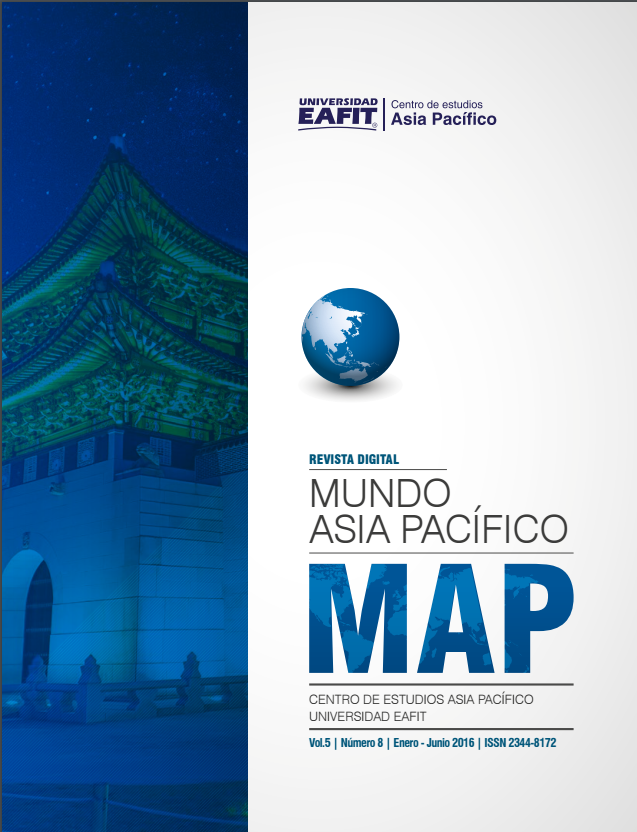Shanghái y Chongqing: las “ciudades a nivel provincia” como estrategias territoriales del Estado en la economía de China
Main Article Content
Keywords
Territorio, territorialidad, infraestructura, Shanghái, Chongqing
Resumen
La configuración de relaciones de poder en los territorios administrativos de China es fundamental para entender los cambios en los procesos económicos y sociales. Dentro de la compleja e inestable geografía política de China, las “ciudades a nivel provincia” (直辖市zhixiashi) se caracterizan por ser los únicos territorios administrados directamente por el gobierno central, siendo recipientes de estrategias económicas y proyectos de infraestructura fundamentales para la economía del país. Este artículo discutirá la reforma de las empresas paraestatales de desarrollo de infraestructura en Shanghái y su aplicación en la ciudad de Chongqing, así como la construcción de la presa de las Tres Gargantas, para mostrar la manera en la cual el gobierno central china establece y administra las “ciudades a nivel provincia” como estrategias territoriales para controlar procesos económicos.
Descargas
Referencias
Cartier, C. (2005). City-space: scale relations and China’s spatial administrative hierarchy. en W. Fulong, & M. Lawrence (eds.), Restructuring the Chinese City. Changing society, economy and space, Londres, Reino Unido: Routledge, 21-38.
Cartier, C. (2011). Urban growth, rescaling and the spatial administrative hierarchy. Provincial China, 3 (1),9-33.
Cartier, C. (2015). Territorial urbanization and the Party-State in China. Territory, Politics, Governance, 3(3), 294-320.
CEDC (Chongqing Expressway Development Corporation). (2012). The New Roads in Operation(行车线路 xingchexianlu), Recuperado de http://www.cqgs.org/webui/news_text.aspx?mk=operate&code=operate_xlt
Chen, A. (1998). Inertia in reforming China’s state -owned enterprises: the case of Chongqing. World Development 26 (3),479-495
China Bureau of Statistics. (2009). China Statistical Yearbook. Pekín, China: National Bureau of Statistics.• Chongqing Bureau of Statistics. (2007). Chongqing Statistical Yearbook (重庆统计年鉴Chongqing tongji nianjian), Chongqing, China: Chongqing Bureau of Statistics and China Statistics Press, Chongqing.
Chongqing Bureau of Statistics. (2010). Chongqing Statistical Yearbook (重庆统计年鉴Chongqing tongji nianjian), Chongqing, China: Chongqing Bureau of Statistics and China Statistics Press, Chongqing.
Chongqing Bureau of Statistics. (2011). Chongqing Statistical Yearbook (重庆统计年鉴Chongqing tongji nianjian), Chongqing, China: Chongqing Bureau of Statistics and China Statistics Press, Chongqing.
Chongqing Bendibao, (2015). Ubicación de la estación de tren rápido en Chongqing (重庆已开通的高铁有哪些 Chongqing yikaitong de gaodie you nali). Recuperado de http://cq.bendibao.com/traffic/2015512/55949.shtm
Cox, K. (2002). Political Geography. Territory, state and society. Oxford, Reino Unido: Blackwell Publishers.
Cui, Z. Y. (2010). The Chongqing Experience: increasing state-owned wealth and civilian prosperity together (重庆经验:国资增值与藏富于民并进Chongqing jingyan: jinxingshi guo zi zeng zhi yu zang fuyu min bing jin)’. China Review of Political Economy, 1 (4), 73-80.
Hong, L. J. (2004). Chongqing: opportunities and risks. The China Quarterly, 178, 448-466.
Huang, Y. S. (2008). Capitalism with Chinese characteristics, Nueva York, Estados Unidos: Cambridge University Press.
Huang, P. (2011). Chongqing: equitable development driven by a third hand?. Modern China, 37, 569-622.
Jackson, S. & Sleigh, A. (2000). Resettlement for China’s Three Gorges Dam: socio-economic impact and institutional tensions’. Communist and Post-Communist Studies, 33, 223-241.• Jae, H. C. & Tao, C. L. (2004). China’s city system in flux: explaining post-Mao administrative changes. The China Quarterly, 180, 945-964.
Jae, H. C. & Tao, C. L. (eds). (2010). China’s local administration. Traditions and changes in the sub-national hierarchy, Londres, Reino Unido: Routledge
Jessop, B. (2000). The crisis of the national spatio-temporal fix and the tendential ecological dominance of globalizing capitalism. International Journal of Urban and Regional Research, 42 (2)
Jessop, B. (2002). The future of the Capitalist state, Londres, Reino Unido: Polity Blackwell Publishing Group.
Jessop, B. (2008). State Power. A strategic-relational approach. Londres, Reino Unido: Polity Blackwell Publishing Group.
Khan, K. (2007). China: framework for credit-based borrowing by the urban development investment corporations (UDICs). East Asia and Pacific Region. Infrastructure Department. The World Bank, Recuperado desiteresources.worldbank.org/INTMF/Resources/339747-1181596204611/Khan.pdf
Leng, T. K. (2010). Centrally administrated municipalities: locomotives of national development, en Jae, H. C. & Tao, C. L. (eds.), China’s local administration. Traditions and changes in the sub-national hierarchy, Londres, Reino Unido: Routledge, 39-62.
Li, X., Li, Y., Cheng, G. & Weng, C. (2013). Evaluation on the counties and districts in the Three Gorges Dam water reservoir’ (重庆三峡库区县域乡村性评价Chongqing sanxia ku quxian yuxiangcunxing pingjie). Economic Geography,33 (6), 125-131.
Lim, K. F. (2014). Spatial egalitarianism as social ‘counter-movement’: on socio-economic reforms in Chongqing. Economy and Society, 43 (3),455-493
Mahadevia, D. (2007). Urban infrastructure financing and delivery in China. Economic and Political Weekly, 42 (11), 964-972.
Ma, L. 2005. Urban administrative restructuring, changing scale relations and local economic development in China. Political Geography 24 (4), 477-497
Pan, H. (2006). Interview with the National People Congress’ delegate Huang Qifan, executive vice major of Chongqing City. Securities Newspaper, Recuperado de http://www.cui-zy.cn/Recommended/Chongqing/从赵启正的“浦东逻辑”到重庆黄奇帆的渝富模式.pdf
People ́s Daily, s.f. 黄奇帆 简历 (Huang Qifan danli), Recuperado de http://ldzl.people.com.cn/dfzlk/front/personPage4947.htm
Salazar, J. (2000). Damming the child of the Ocean: the Three Gorges Project. The Journal of Environment & Development 2 (2), 160-174.
Sassen, S. (1991). The Global City: New York, London, Tokyo”, Estados Unidos: Princeton University Press.
Shanghai Bureau of Statistics. (2011). Shanghai Statistical Yearbook, (上海统计年鉴Shanghai tongji nianjian). Shanghai, China: Shanghai Bureau of Statistics
Shih, V. (2008). Factions and finance in China. Elite conflict and inflation, NuevaYork, Estados Unidos: Cambridge University Press.
The World Bank. (2012). World development indicators and global development finance. Recuperado de http://databank.worldbank.org/data/home.aspx
Walcott, S. (2007). The dragon’s tail: utilizing Chengdu and Chongqing technology development zones to anchor West China economic advancement. Journal of Chinese Economic and Business Studies, 5 (5),131-145.
Wedeman, A. (2003). From Mao to market: rent seeking, local protectionism and marketization in China, Nueva York, Estados Unidos: Cambridge University Press.
Yi, S. (2012). The dream of the city (城市梦想 Chengshi mengxiang), Chongqing, China: Chongqing University Press.
Zhou, Y. & Chen, Z. (2008). Chongqing (重庆 Chongqing). Contemporary China Urban Development Series. Pekin, China: Contemporary China Publishing House

